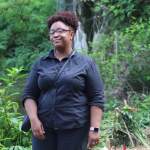On the surface, there appeared to be little common ground and little to celebrate.
A 16-year-old white girl, murdered while bicycling across a bridge on her way to school, and a black woodcutter who lived nearby burned alive for the crime. Two tragedies, no legal resolution to either.
And yet, not one but two gatherings Sunday afternoon found joy in loss, hope in injustice.
A group of Overton High School students came first, dedicating a marker alongside busy Summer Avenue to Ell Persons. The 50-something woodcutter was dragged from a train in Potts Camp, Mississippi, 100 years ago Sunday and lynched the next day on the Memphis outskirts near the Wolf River in a carnival-like setting.
An hour later Sunday afternoon, a crowd of more than 100 gathered nearby under a large tent, farther off Summer nearer the Wolf River. They participated in an interfaith prayer service commemorating the centennial of the Persons lynching. Another marker was dedicated during the service arranged by the Lynching Sites Project. Memphis Mayor Jim Strickland, Shelby County Mayor Mark Luttrell and U.S. Rep. Steve Cohen, D-Tenn., all spoke.
"It's important to remember there were two injustices," Shelby County historian Jimmy Ogle noted before the Overton unveiling. "No one was ever convicted for either crime."
At the time, however, public sentiment convicted Persons. News report said police used "physical and psychological force" to get a confession, even though law enforcement disagreed on his guilt. City police thought the culprit was white, but the county sheriff directed the investigation toward African-American woodcutters.
Before Persons could be tried, a mob seized him from the train as he was being returned from Nashville, where he had been sent for safekeeping after his arrest until the trial date.
The time and place of his lynching was announced in the newspaper the next day, and a carnival atmosphere was reported as cars jammed Macon Road from the estimated 5,000 spectators who turned out to watch Persons be set afire after he was doused with gasoline. Reports said some spectators took parts of the charred body as souvenirs, and his head and foot were thrown at African-American pedestrians on Beale Street.
Meanwhile, no one else was ever arrested for the death of Antoinette Rappel, the Treadwell School student whose decapitated body was found at the old Wolf River Bridge near what is now Summer Avenue.
"We can't right the wrong of 100 year ago," Strickland said during the prayer service, "but we acknowledge the wrong so that all our community is aware and all of our community remembers. Today, we gather as a community to remember and to celebrate ... to encourage healing."
The separate dedication by the group of Overton students spoke to the kind of generational learning and healing that many of those at the prayer service longed for. The project came about through the school's Facing History and Ourselves and Students Uniting Memphis class.
"They found out this happened and said, 'Oh my god, this happened right here in our community and we never knew about it," said Marilyn Taylor, who teaches the class. "We even came out here one day and tromped through the mud to get back there and find the site."
Student Khari Bowman said the project gave her knowledge that will influence her thinking for the rest of her life.
"For me, it's like a symbol of hope for our future generations," Bowman said, "because, I don't know, we took something that was not known and we made it known."
Or as Rev. Roslyn Nichols put it in her opening remarks at the prayer service: "Truth crushed to earth will rise."
Source date:
May 22 2017








































